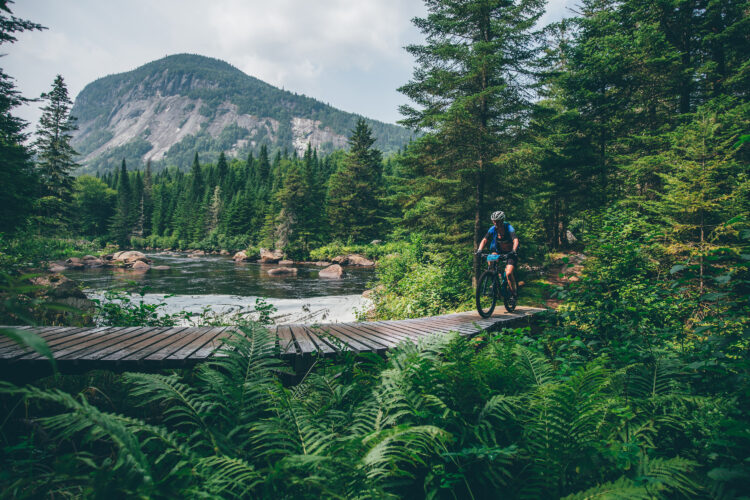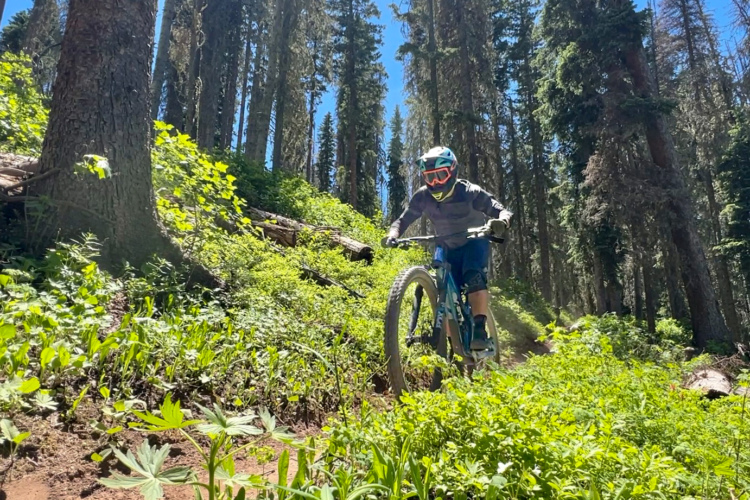When I first moved from the east coast to Colorado, I noticed that what we called mountain biking back east is much different than what people call mountain biking in the west. To that end, I’ve decided to concentrate on discussing some differences in trail types from a regional perspective. Specifically, I’ll compare biking on the east coast versus riding in the wild wild west. Since I’ve ridden a lot in the Southeast and a bit in the Midwest and California (well, ok actually only one trail in the Midwest but I rode it twice!) and now live and bike exclusively in Colorado, I feel that I have just enough experience to write on the subject.
The main difference between riding on the east coast and in the wild west is the types of obstacles that you may encounter on the trail. In the east you are mostly concerned about trees, tree roots, creek crossings, and sometimes mud. In the west, sand, rocks, and steep trails are plentiful and are sure to keep you on your toes when you’re out on the trail. Both types of obstacles can be extreme in different ways. For example, there’s a spot on the Owl’s Roost trail in Greensboro, NC where the trail makes a steep drop over the roots of a sizeable tree. The roots pretty much tell you where to go and if you hit one the wrong way, you’re doin’ an endo. Likewise a recent rain turns this into a totally different obstacle as you now have to contend with the fact that the underlying ground is slick and so are the roots. The one Midwestern trail I’ve ridden (Caesar’s Creek) has a similarly difficult section due to roots and the shear steepness of the descent. One of the times I rode it the hill was still slick from rain and I ended up in a (somewhat) controlled slide down the hill between the roots. Scary (but fun) stuff.
Another example of difficult obstacles that may be encountered in east coast riding are stream crossings. These aren’t as common in many parts of the west because there isn’t that much water in most areas. Anyway, take for example an easy, smooth trail like the Modoc Trail in South Carolina. This is one of the fastest trails I’ve ridden but it is punctuated by several technical stream crossings. On some of these crossings I’ve gone back over and over until I can make it across without getting off the pedals. In some cases, the shear volume of water makes the stream crossing difficult. At times a portion of the Umstead State Park trail near Raleigh, NC is submerged under a few feet of water after a large rain. This can be dangerous due to unseen obstacles located just below the surface of the brown, turbulent waters.
Finally (for east coast obstacles anyway) trees can often pose technical challenges to some of the best riders (and the worst ones as well). Trees in their normal vertical position usually pose little problem for riders (unless they are spaced really close together which is the cause of this video I took). However, when trees fall across a trail this often means picking up the Huffy and lifting it over the tree. In some cases, nice riders pile up logs or rocks to assist you over these speed bumps. These ramps take practice, however, and can often lead to some nasty face plants. A trail with a good number of fallen trees can be found in Chapel Hill, NC. These are more common than you might think on unmaintained trails in heavily wooded areas.
Now you wanna know about the obstacles out here in the wild west. Well for starters, get used to surfin the sand. For a place like Colorado located 1000 miles from the nearest beach, you would be surprised by the sandy conditions on trails like Captain Jack’s in Colorado Springs. This trail is literally like skiing on a bike in some places. Sand is difficult to steer in and really really stinks for traction (try going in the uphill direction on this trail). The sand in Colorado can be of varying grain sizes from gravel to fine beach sand. The best way to handle it is to keep your momentum and always look for a solid place to regain traction if needed.
While sand may sound a little lame to most riders pining for an extreme Colorado biking excursion, most would agree that rocks are what separate the mountain bikers from the beach cruisers. But they type of rocks I’m talking about here are of the stationary type (not little boulders or gravel littering the trail). These rocks are pretty much the foundation for most of the trails here and in places like Moab, Utah (but can also be found sparingly in North Carolina?s Dupont State Park). For example, the Cheyenne trail in Palmer Park, Colorado Springs is rated a “black diamond” trail due to the regular 1-3 foot drops that occur along the descent. You really have to get a good rhythm going on trails like this, almost like riding down stairs on campus. Bigger drops abound on trails like these and can be as extreme as you wanna be.
Speaking of drops off rocks I once saw this guy on Real TV or some show like that that wanted to attempt a 40 foot drop off a face near some ski resort out here in Colorado. They had cameras there and tons of people and the guy totally busts off the thing. It was crazy but it just shows you that there is always an obstacle out there that will challenge even the best bikers.
Finally, the shear steepness of many trails in the west is markedly different from any trails found in the east. Actually, I should start by saying that the length of many climbs / descents is really different in the west. On some trails you could expect to be climbing for 10 miles and ascending thousands of feet in elevation. The Barr trail leading to the top of Pikes Peak comes to mind here. Gold Camp road is a gradual climb that winds well over 10 miles and provides links to Captain Jacks, The Chutes, and other nice singletrack trails. Of course there are very steep trail sections located in the east where you have to stand on your pedals and straddle your seatpost but very few of these last more than a few hundred yards. The west has some sweet descents that are as exciting and challenging as any you would want to ride.
Hopefully this information has been helpful and educational. I know before I rode out here in Colorado I had no idea how different the riding could be from Georgia and North Carolina trails. Remember, no matter where you ride or what kind of terrain you encounter, the most important thing is to have fun and be courteous to other riders. Over and out.





















2 Comments
Mar 28, 2015
Apr 17, 2015